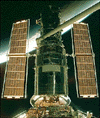Robotics is the scientific study of robots and their uses. A robot is any mechanical device that is able to be controlled from a remote source. The word robot comes from the Czech word 'robota' meaning 'a slave', so the connection is pretty clear. In modern times, robots have become quite sophisticated as electromechanical devices that can be programmed to do a variety of set routines.
Robotics aids medical research
Recently Professor Neville Hogan of MIT has engineered a robot to help
people recover use of a limb after stroke paralysis. His ingenious device
assists people to develop appropriate strength to move objects and 'teach'
their brains to use the paralysed muscles again. In the simplest form,
a robotic arm is held by the patient as that person tries to move towards
a target on a computer screen. While the person is travelling in the right
direction, the mechanical arm follows. As a different direction, or more
strength, is needed the robot detects this and moves the person's hand
and arm appropriately. As an offshoot of this research scientists are
gaining an insight into how we learn to move.
Robots fly!
The unit Forces in
mechanical flight is concerned with the aerodynamics of a wing, and
the Bernoulli effect. This works well with aircraft, but how does it apply
to insects, such as hawk moth, where the wings move up and down more than
a hundred times every second? To find out, a robotic hawk moth has been
built, ten times larger than the actual insect. This robot has a smoke
trail from the wing tips and when suspended in a wind tunnel the air flow
can readily be seen. What was the result? The Bernoulli effect does apply
and the moth uses a particularly intricate series of wing patterns to
enable it to fly.
Robotic explorers - potential life
savers
Because robots can be controlled from a remote location, and because computer
technology allows information from the robot to be read in a variety of
ways, they are ideal for exploration. Sometimes they can be fed down tunnels
to find out what's happening - if there has been an accident in a mine
for example. The data can indicate whether there are noxious gases, where
it is safe or unsafe to go, and the general conditions within the tunnel.
Robots are used to investigate suspected explosive devices by sensing
the characteristic chemicals that are contained in such devices. They
also allow a close up view of the suspect object without endangering human
life.
Factory robots
Many factories are automated and robotic devices carry out tasks once
done by humans. One particular example is on motor car production lines.
Spot welds are able to made quickly and accurately in confined areas where
a human worker could not easily reach. In the paint shop, the intricate
patterns required to paint a car body are also controlled by robots, not
only being faster and more precise, but also reducing the risk to workers
from paint and solvent inhalation.
Robots integrate science concepts
The advent of robotics has only been made possible by the development
of modern technology. A typical robot, using the principles of feedback,
can respond to changes in the environment and adapt its behaviour accordingly.
Robots use a variety of sensing devices, often much more sensitive than
those in humans. They also measure forces to great accuracy and respond
with such precision that picking up a fragile object such as an egg and
placing it in a box can be completed continuously with no tiring or lack
of concentration. Two of the most famous robots are probably the Sojourner
Rover that explored the surface of Mars and the Hubble space telescope
with its magnificent images of the Universe.
| Copyright owned by the State of Victoria (Department of Education and Early Childhood Development). Used with Permission. |
|
|||||||||||||||||||||||

